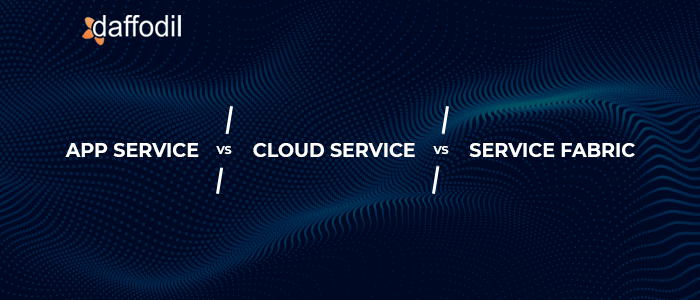
The two most prominent ways to deploy your applications to the Microsoft Azure cloud are: Azure App services and Cloud services while Service Fabric is a container orchestrator for deploying microservices across machines.
Both App service and Cloud service are hosted on virtual machines, developers have more control over virtual machines while using Cloud service. Cloud service provides the user with more flexibility while automatically managing the app container.
In this article, we will run a comparison between App Service, Cloud Service and Service Fabric.
Also Read: Azure vs AWS: Best Cloud Service for Serverless Architecture
App Service
Azure App Service is a platform as a service (PaaS) by Microsoft. It runs on a set of virtual machines in both dedicated and shared mode based on your plan. The four major types of App services are: Web App, API App, Logic App, and Mobile App. The benefits of using App Service are aplenty. Among the various advantages a few worth mentioning are that it is easier and faster to deploy than Cloud services. The deployment slots are free with built-in A/B testing features and are extendable with site extensions. There are a few disadvantages as well such as no access to the server, inability to use all monitoring tools, limited Windows performance and VM sizes to choose from.
With the Azure App service you can develop the following apps:
Web App: It is available for both Linux and Windows and gives developers more control to deploy and scale web apps in different languages such as Java, PHP and more.
Web App for Containers: This one lets developers use their Docker formatted container images as well as deploy and run them.
Functions App: This is used on the serverless computing enabling building of the serverless functions that can be auto-scaled.
API App: With this, the developers can easily host, build and use APIs coded in different languages. They can also benefit from features like connectivity to on-premise resources or turnkey API security.
Logic App: By using this the developers can create workflows triggered to execute specific steps with each step triggering an API app to handle certain functions.
Cloud Service
The first Platform as a service (PaaS) by Microsoft Azure – Cloud service deploys web apps and background services on to virtual machines. Azure does all the managing of servers from deployment to updates. Web Roles are to host web applications while Worker Roles host background services. Main advantages of using Cloud Service are you get full server admin access, get to choose from several VM sizes, and install an array of software on the server. A few disadvantages are Cloud service is a tad slow to deploy, with expensive staging slots. You also can’t combine several applications or change VM size without redeploying.
Azure Cloud services are available in two roles: Web role and worker role.
Web Role: It deploys the app automatically and hosts it through Internet Information Services (IIS). It is used to host basic apps.
Worker Role: It runs the app as a single entity without the use of IIS. Worker role is used to run complex background services.
Service Fabric
Service Fabric by Microsoft is used to deploy and manage applications in a fraction of seconds even with multiple apps running on a machine. The main benefit of using Service fabric is that you can mix services in processes and in containers in the same app. It provides an uncomplicated and effective runtime supporting stateless and stateful microservices. What differentiates it from Cloud Service and App Service is its support to microservices.
Also Read: Distributed Cloud Computing: Benefits and Limitations
Conclusion
Both App services and Cloud services offer specific benefits to deploy applications to Azure. The biggest advantage of using them is that you don’t have to use your own virtual machines. If you are confused about which one to go for then we are here to help. Book a free consultation today with our experts to know which one suits your business goals better.



